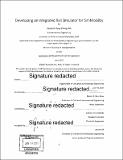| dc.contributor.advisor | Moshe E. Ben-Akiva and Carlos Lima Azevedo. | en_US |
| dc.contributor.author | Koh, Kenneth Hang Chang | en_US |
| dc.contributor.other | Massachusetts Institute of Technology. Department of Civil and Environmental Engineering. | en_US |
| dc.date.accessioned | 2017-09-15T15:34:01Z | |
| dc.date.available | 2017-09-15T15:34:01Z | |
| dc.date.copyright | 2017 | en_US |
| dc.date.issued | 2017 | en_US |
| dc.identifier.uri | http://hdl.handle.net/1721.1/111434 | |
| dc.description | Thesis: S.M. in Transportation, Massachusetts Institute of Technology, Department of Civil and Environmental Engineering, 2017. | en_US |
| dc.description | Cataloged from PDF version of thesis. | en_US |
| dc.description | Includes bibliographical references (pages 91-92). | en_US |
| dc.description.abstract | High-frequency rail transit systems such as subways play a key role in urban transportation; as such, the choices made in the design, implementation, and operation of rail networks are important. To fully understand the impacts of these choices, there is a need for an integrated analysis, where the rail system is analyzed as a component of a larger transportation network. This thesis focuses on designing a rail simulator as an integrated component of the SimMobility simulation platform, improving upon existing simulators via complete integration with the comprehensive features of SimMobility, enabling it to account for multimodal demand by dynamically adapting to changes in the entire network. A second aim is flexibility; through the implementation of a Service Controller able to read user-written LUA files, it is shown that the rail simulator is able to model a wide variety of different scenarios and policies. The rail simulator is then calibrated using a novel sequential calibration method, where individual parameters are estimated sequentially. The advantage of this method is its computational speed and ability to operate with only automatic fare card (AFC) data, not requiring automatic train control (ATC) data. This approach is shown to result in a 30% error in travel times, making it an ideal first-step approach to generate seed values that can be used for more comprehensive calibration methods. Finally, the rail simulator is used to conduct a historical disruption scenario and investigate the effects of a simple mitigating strategy. The effects of the various scenarios on not only the rail network, but also the road network and passenger welfare, are captured, thus demonstrating the usefulness of an integrated simulator in research and future planning. | en_US |
| dc.description.statementofresponsibility | by Kenneth Hang Chang Koh. | en_US |
| dc.format.extent | 92 pages | en_US |
| dc.language.iso | eng | en_US |
| dc.publisher | Massachusetts Institute of Technology | en_US |
| dc.rights | MIT theses are protected by copyright. They may be viewed, downloaded, or printed from this source but further reproduction or distribution in any format is prohibited without written permission. | en_US |
| dc.rights.uri | http://dspace.mit.edu/handle/1721.1/7582 | en_US |
| dc.subject | Civil and Environmental Engineering. | en_US |
| dc.title | Developing an integrated rail simulator for SimMobility | en_US |
| dc.type | Thesis | en_US |
| dc.description.degree | S.M. in Transportation | en_US |
| dc.contributor.department | Massachusetts Institute of Technology. Department of Civil and Environmental Engineering | |
| dc.identifier.oclc | 1003292652 | en_US |
